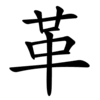革
| ||||||||
| ||||||||
Translingual
| Stroke order | |||
|---|---|---|---|
 | |||
Han character
革 (Kangxi radical 177, 革+0, 9 strokes, cangjie input 廿中十 (TLJ), four-corner 44506)
- Kangxi radical #177, ⾰.
Derived characters
References
- KangXi: page 1385, character 1
- Dai Kanwa Jiten: character 42710
- Dae Jaweon: page 1899, character 15
- Hanyu Da Zidian (first edition): volume 7, page 4325, character 1
- Unihan data for U+9769
Chinese
| simp. and trad. |
革 | |
|---|---|---|
| alternative forms | 䪂 𩎎 | |
Glyph origin
| Historical forms of the character 革 |
|---|
| Shuowen Jiezi (compiled in Han) |
| Small seal script |
 |
Characters in the same phonetic series (革) (Zhengzhang, 2003)
Pictogram (象形) – a stretched animal hide: the upper is head, the bottom is the tail and legs.
Compare 皮 (pí), which also features a hide.
Pronunciation
Definitions
革
Compounds
Derived terms from 革
|
|
Pronunciation
Compounds
Derived terms from 革
|
References
- “革”, in 漢語多功能字庫 (Multi-function Chinese Character Database), 香港中文大學 (the Chinese University of Hong Kong), 2014–
Japanese
Readings
Compounds
- 革易 (kakueki)
- 革新 (kakushin) : innovation; progress
- 革正 (kakusei)
- 革弊 (kakuhei)
- 革命 (kakumei) : revolution
- 革面 (kakumen)
- 沿革 (enkaku)
- 改革 (kaikaku) : reform
- 皮革 (hikaku)
Korean
Vietnamese
This article is issued from Wiktionary. The text is licensed under Creative Commons - Attribution - Sharealike. Additional terms may apply for the media files.